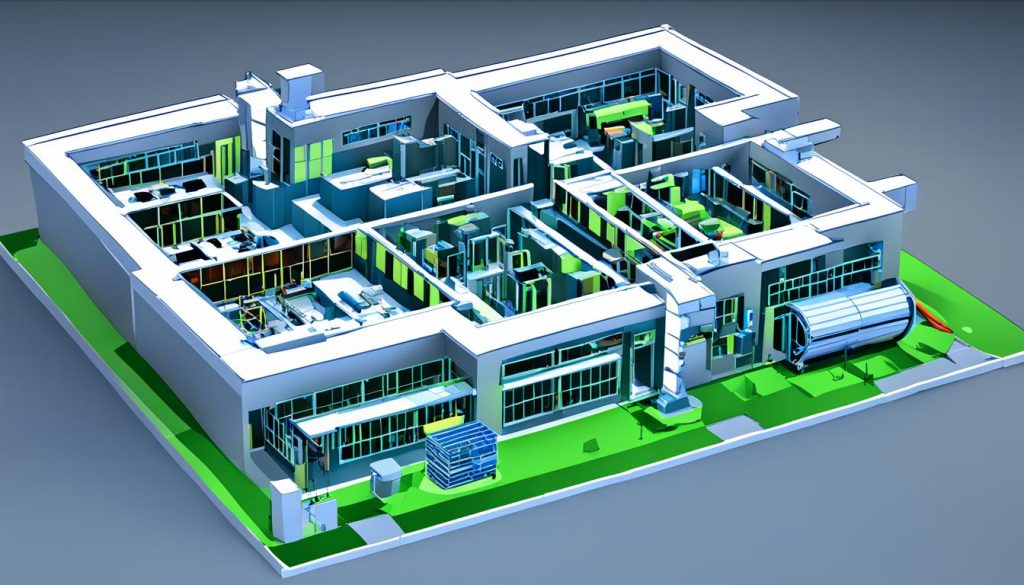AutoCAD HVAC software lets you do precise load calculations with the HVAC Load Calculation Extension. This tool is great for designing efficient HVAC systems for big buildings. It makes sure your systems work well and use less energy.
The extension uses the ASHRAE 2005 Fundamentals radiant time series method. This method helps figure out the total cooling and heating loads. With this software, you can size your HVAC equipment right. This means your system will work better and use less energy.
AutoCAD HVAC software makes your work easier by combining building info, weather data, and material properties. You can easily put in system details, check the results, and make detailed reports for your HVAC projects.
The HVAC Load Calculation Extension is for AutoCAD MEP 2009 and AutoCAD Revit MEP Suite 2009 users on Autodesk Subscription. Using this tool makes your calculations more accurate and saves you time in the design process.
Understanding HVAC Load Calculations and Their Importance
HVAC load calculations are key to designing efficient heating and cooling systems for buildings. They help figure out the right equipment size needed to keep indoor temperatures comfy. Let’s dive into the basics of HVAC load analysis and why it’s important in building design.
What are HVAC load calculations?
HVAC load calculations estimate how much heating or cooling a building needs. They consider the building’s size, insulation, windows, and how many people use it. By simulating HVAC loads accurately, engineers can find the perfect size for HVAC equipment for the best performance.
Why accurate load calculations matter
Getting HVAC load analysis right is crucial for many reasons:
- Energy efficiency: The right-sized systems use less energy, cutting costs and pollution.
- Comfort: Correct calculations mean consistent temperatures in the building.
- Equipment longevity: Systems that fit well last longer and wear out less.
- Cost-effectiveness: Avoiding big equipment saves money upfront and over time.
The role of AutoCAD in HVAC design
AutoCAD has changed HVAC design for the better. It lets engineers make detailed building models and do complex load calculations fast and right. AutoCAD’s HVAC tools make designing systems easier, cutting down on mistakes and boosting efficiency.
With AutoCAD, you can easily add building details, simulate loads, and get detailed reports. This blend of design and analysis tools makes making top-notch HVAC systems for any project simpler than before.
Getting Started with AutoCAD HVAC Software
AutoCAD HVAC software is a powerful tool for designing HVAC systems. To start, get to know its main features and how it works with other tools. It works well with AutoCAD MEP and Revit MEP, making your design work smoother.
First, learn how to bring building info into the software. The extension uses gbXML files, cutting down on manual data entry. This lets you spend more time on designing HVAC systems and less on data.
After doing your calculations, you can send the results back to AutoCAD MEP or Revit MEP. This helps you accurately size ducts and pipes. It ensures your HVAC design meets all the needed standards.
| Software | Import Format | Export Capability |
|---|---|---|
| AutoCAD MEP | gbXML | Duct and pipe sizing |
| Revit MEP | gbXML | Duct and pipe sizing |
Practice importing and exporting data between these platforms to get better at AutoCAD HVAC. This skill is key for creating efficient and precise HVAC designs. It will help you in your career, making your work easier and more accurate.
Key Features of AutoCAD HVAC Load Calculation Extension
AutoCAD HVAC software is packed with features for accurate HVAC load calculations. It boosts your HVAC energy modeling skills. This makes it a must-have for HVAC pros.
Building Information Import Capabilities
The AutoCAD HVAC extension makes your work easier by letting you import building data directly. You can quickly add floor plans, wall sizes, and material details. This saves time and cuts down on mistakes in your HVAC load calculations.
Weather Data Integration
For HVAC load calculations, having the right climate info is key. This extension comes with weather data for over 800 cities. It ensures your calculations consider local temperature highs and lows, humidity, and seasonal changes.
U-value Database for Common Materials
The built-in U-value database makes thermal performance easy to assess. It lists heat transfer rates for common building materials. This means you can do HVAC energy modeling fast and accurately without entering data manually.
Reporting and Visualization Tools
There are detailed reporting tools to help you share your HVAC load calculations clearly. The extension creates summary reports, detailed breakdowns, psychrometric charts, and graphs of your findings.
| Feature | Benefit |
|---|---|
| Building Import | Reduces manual input time |
| Weather Data | Ensures location-specific accuracy |
| U-value Database | Simplifies material thermal analysis |
| Reporting Tools | Facilitates clear result presentation |
With these strong features, the AutoCAD HVAC load calculation extension helps you make precise HVAC load estimates. It lets you design for the best energy efficiency.
Perform Accurate Load Calculations for HVAC with AutoCAD
AutoCAD HVAC software changes how you do load calculations. It makes the process easier and more precise. Let’s see how to use it well.
First, enter your building’s details into the AutoCAD HVAC software. This includes wall types, window sizes, roof materials, and door specs. The software has a big database of common materials, which saves time and cuts down on mistakes.
Then, set up your HVAC system details. Choose the system type, like a split system, packaged unit, or central plant. Add in air distribution methods and equipment efficiencies too.
Remember to think about internal loads. These are things like people, lights, and appliances. The software takes into account the heat these create, making sure your cooling load calculations are right.
| Building Element | Input Required | Impact on Load |
|---|---|---|
| Walls | Material, thickness, insulation | Heat gain/loss through conduction |
| Windows | Size, glazing type, orientation | Solar heat gain, conduction |
| Roof | Material, insulation, color | Heat gain from sun exposure |
| Occupancy | Number of people, activity level | Sensible and latent heat loads |
By following these steps, you’ll get the most out of AutoCAD HVAC software for accurate load calculations. This method makes sure your HVAC designs are both comfy and efficient.
Inputting Building and System Characteristics
Starting with accurate HVAC load analysis means entering building and system details in AutoCAD HVAC correctly. This step is key to making sure your calculations match real-world conditions. Let’s look at the main parts of entering data for accurate load calculations.
Defining HVAC System Parameters
In AutoCAD HVAC, you must enter many system parameters. These include supply temperatures for cooling and heating, ventilation rates, and fan specs. You also set cooling and heating setpoints, figure out duct sizes, and add safety factors.
| Parameter | Description | Typical Range |
|---|---|---|
| Supply Air Temperature | Temperature of air supplied to spaces | 55-60°F (Cooling), 90-120°F (Heating) |
| Ventilation Rate | Amount of fresh air introduced | 15-60 cfm per person |
| Fan Efficiency | Energy efficiency of HVAC fans | 60-85% |
| Duct Sizing | Cross-sectional area of ducts | 0.1-0.2 in. w.g. per 100 ft |
Specifying Room and Area Details
AutoCAD HVAC lets you enter specific room details. This includes wall, window, roof, and door areas. You also need to consider skylights and partitions. These details are key for an accurate HVAC load analysis.
Accounting for Internal Loads
Internal loads greatly affect HVAC system design. In AutoCAD HVAC, you’ll enter data on occupancy, electrical appliances, and other heat sources. This detailed approach makes sure your HVAC load calculations cover all factors that affect indoor climate.
By entering these building and system details carefully, you lay the groundwork for a precise HVAC load analysis. This focus on detail early in HVAC design leads to more efficient and effective systems.
Utilizing ASHRAE Standards in AutoCAD HVAC Calculations
ASHRAE standards are key in HVAC load calculation software. They make sure your HVAC energy modeling follows the best practices. Using AutoCAD for HVAC design, ASHRAE standards help you get precise and trustworthy results.
The AutoCAD HVAC Load Calculation Extension uses formulas from the ASHRAE Handbook of Fundamentals. This lets you do peak cooling and heating load calculations that meet industry standards. With this software, you can design HVAC systems that meet or beat ASHRAE requirements.

| ASHRAE Standard | Application in HVAC Design | Impact on Load Calculations |
|---|---|---|
| Standard 55 | Thermal Comfort | Influences temperature and humidity setpoints |
| Standard 62.1 | Ventilation | Determines required outdoor air flow rates |
| Standard 90.1 | Energy Efficiency | Sets minimum efficiency requirements for HVAC equipment |
Using these standards in your HVAC load calculation software ensures your designs follow codes and offer the best comfort and efficiency. The AutoCAD HVAC extension makes this easier, letting you create top-notch HVAC systems.
Analyzing and Interpreting Load Calculation Results
After running HVAC load simulations, you’ll need to analyze the results for effective HVAC design automation. AutoCAD HVAC software provides comprehensive reports and visual tools. These help you understand the data and make informed decisions.
Understanding Summary and Detailed Reports
HVAC load analysis software generates two main types of reports: summary and detailed. Summary reports give you a quick overview of total loads for each space. Detailed reports break down loads by components like walls, windows, and internal gains.
These reports help you identify areas that need attention in your HVAC design.
| Report Type | Information Provided | Use Case |
|---|---|---|
| Summary | Total loads per space | Quick overview, initial sizing |
| Detailed | Load breakdown by component | In-depth analysis, troubleshooting |
Interpreting Psychrometric Data
Psychrometric reports show air properties like temperature, humidity, and enthalpy. This data is crucial for sizing cooling and dehumidification equipment. You can use psychrometric charts to visualize air conditions and processes.
Using Graphical Representations for Better Insights
Graphs and charts in HVAC load simulation software offer visual insights into load distributions. Pie charts show percentage breakdowns of different load sources, while bar graphs compare loads across spaces.
These visual tools help you quickly spot patterns and anomalies in your HVAC load analysis results.
By mastering the interpretation of these reports and visuals, you can streamline your HVAC design automation process. This leads to more efficient systems.
Optimizing HVAC Design for Energy Efficiency
AutoCAD HVAC software lets you make HVAC designs that save energy. It uses advanced energy modeling to make your projects more sustainable and cost-effective.
The Load Calculation Extension in AutoCAD HVAC prevents oversized equipment, which wastes energy. It helps you pick the right-sized equipment for the best efficiency.

Designing HVAC systems is more sustainable with AutoCAD HVAC. It lets you test different designs to find the most energy-efficient one for each project.
- Analyze various equipment combinations
- Evaluate the impact of building orientation
- Assess the effectiveness of insulation materials
- Optimize ductwork layout for minimal energy loss
AutoCAD HVAC’s BIM-supported workflow helps teams work together. Architects, engineers, and energy consultants can share ideas from start to finish. This ensures energy efficiency is always considered.
Using AutoCAD HVAC for energy modeling makes HVAC systems better than just meeting codes. They go beyond energy standards, saving money and reducing harm to the environment.
Conclusion
AutoCAD HVAC software changes the game for load calculations. It brings together powerful tools and features to make HVAC system design easier. Now, you can quickly import building info, use weather data, and get precise U-value calculations from big material databases.
The HVAC Load Calculation Extension for AutoCAD MEP and Revit MEP elevates your design skills. It has tools for sizing equipment and planning energy-efficient systems. This makes creating sustainable HVAC designs a breeze.
Using the software, you’ll quickly get the hang of doing accurate load calculations. You’ll find steps like defining system parameters and analyzing psychrometric data easier. The software’s graphical views and detailed reports give you key insights. This helps you make smart choices and improve your HVAC designs.
Learning to do accurate load calculations with AutoCAD HVAC software prepares you for complex projects. This software saves time and ensures your designs are precise. It sets a high standard for HVAC engineering.





0 Comments